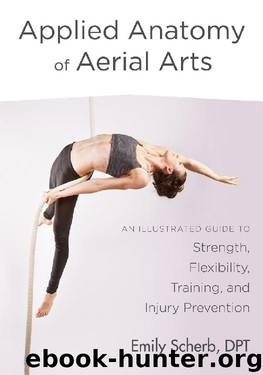Applied Anatomy of Aerial Arts: An Illustrated Guide to Strength, Flexibility, Training, and Injury Prevention by Emily Scherb

Author:Emily Scherb [Scherb, Emily]
Language: eng
Format: epub, mobi
Tags: Non-Fiction, Sports, Science, Guide, Medical, Training
ISBN: 9781623172176
Publisher: North Atlantic Books
Published: 2018-06-12T00:00:00+00:00
Muscles Involved: The transversus abdominis stabilizes the spine and pelvis, and then the iliopsoas flexes the hips with help from the tensor fasciae latae. The quadriceps also assist with hip flexion as they keep the knees straight. Next, the rectus abdominis fires to posteriorly tip the pelvis and flex the lumbar spine. Once the lower body is flexed, the latissimus dorsi fires to bring the arms into adduction, toward the body. Finally, the middle trapezius engages to retract the shoulder blades and create a stable platform to support the body in a basket position.
Common Errors: Shoulders closing too early. Because the legs are straight during this movement, there is more load on the core. That’s why it is more likely that the hip flexors will engage sooner or more than the abdominals, pulling the aerialist into lumbar extension and making the posterior pelvic tilt and lumbar flexion needed to complete the motion much more difficult.
Bent knees can indicate that the iliopsoas are not yet strong enough to lift the legs, or the spine is not adequately stabilized to support the movement.
Download
Applied Anatomy of Aerial Arts: An Illustrated Guide to Strength, Flexibility, Training, and Injury Prevention by Emily Scherb.mobi
This site does not store any files on its server. We only index and link to content provided by other sites. Please contact the content providers to delete copyright contents if any and email us, we'll remove relevant links or contents immediately.
| Anatomy | Bacteriology |
| Biochemistry | Biostatistics |
| Biotechnology | Cell Biology |
| Embryology | Epidemiology |
| Genetics | Histology |
| Immunology | Microbiology |
| Neuroanatomy | Nosology |
| Pathophysiology | Physiology |
| Virology |
Tuesdays with Morrie by Mitch Albom(4664)
Yoga Anatomy by Kaminoff Leslie(4289)
Science and Development of Muscle Hypertrophy by Brad Schoenfeld(4073)
Bodyweight Strength Training: 12 Weeks to Build Muscle and Burn Fat by Jay Cardiello(3895)
Introduction to Kinesiology by Shirl J. Hoffman(3711)
How Music Works by David Byrne(3157)
Sapiens and Homo Deus by Yuval Noah Harari(2969)
The Plant Paradox by Dr. Steven R. Gundry M.D(2530)
Churchill by Paul Johnson(2493)
Insomniac City by Bill Hayes(2480)
Coroner's Journal by Louis Cataldie(2413)
Hashimoto's Protocol by Izabella Wentz PharmD(2315)
The Chimp Paradox by Peters Dr Steve(2279)
The Universe Inside You by Brian Clegg(2085)
The Immune System Recovery Plan by Susan Blum(2013)
Don't Look Behind You by Lois Duncan(2013)
The Hot Zone by Richard Preston(1969)
Endure by Alex Hutchinson(1934)
Woman: An Intimate Geography by Natalie Angier(1872)
